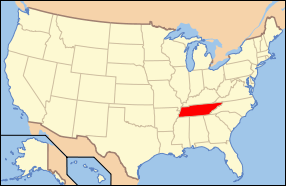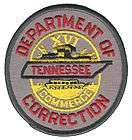Tennessee Department of Correction
| Tennessee Department of Correction | |
|---|---|
| Abbreviation | TDOC |
|
Patch of the Tennessee Department of Correction | |
| Agency overview | |
| Formed | 1923 |
| Legal personality | Governmental: Government agency |
| Jurisdictional structure | |
| Operations jurisdiction* | State of Tennessee, USA |
 | |
| Map of Tennessee Department of Correction's jurisdiction. | |
| Size | 42,169 square miles (109,220 km2) |
| Population | 6,214,888 (2008 est.)[1] |
| General nature | |
| Operational structure | |
| Headquarters |
6th Floor Rachel Jackson Building Nashville, Tennessee |
| Agency executive | Tony Parker, Commissioner |
| Facilities | |
| Correctional Facilitys | 17 |
| Website | |
| Tennessee DOC Website | |
| Footnotes | |
| * Divisional agency: Division of the country, over which the agency has usual operational jurisdiction. | |
The Tennessee Department of Correction (TDOC) is a Cabinet-level agency within the Tennessee state government responsible for the oversight of more than 20,000 convicted offenders in Tennessee's fourteen prisons, three of which are privately managed by the Corrections Corporation of America. The department is headed by the Tennessee Commissioner of Correction, who is currently Tony Parker. TDOC facilities' medical and mental health services are provided by Corizon.[2] Juvenile offenders not sentenced as adults are supervised by the independent Tennessee Department of Children's Services, while inmates granted parole or sentenced to probation are overseen by the Department of Correction (TDOC)/Department of Parole. The agency is fully accredited by the American Correctional Association.[3] The department has its headquarters on the sixth floor of the Rachel Jackson Building in Nashville.[4]
History
In 1923, the Administrative Reorganization Act created the Department of Institutions, charged with the management of the Tennessee prison system. In 1933 the General Assembly passed legislation that created an Industrial Division within the Department of Institutions.
In 1937, the name was changed to the Department of Institutions and Public Welfare, which had responsibility for a Confederate Soldier's Home, a School for the Blind, a School for the Deaf, a Tennessee Industrial School at the state penitentiary, the Blind Commission, the Clover Bottom Developmental Center, three regional psychiatric hospitals, and the Gailor Center.
In 1939, the Department of Institutions and Public Welfare was divided into a Department of Institutions and a separate Department of Public Welfare.
In 1953, the responsibility over mental health facilities was separated into the Department of Mental Health, and in 1955, the Department of Institutions arrived at its present name, the Department of Correction.
In 1961, the state legislature established the Division of Adult Probation and Parole within the Department.
In 1963, an Act created a Division of Youth Services and provided for an Assistant Commissioner.
In 1970, a Division of Rehabilitative Services was created by the General Assembly. In that same year, an act passed that relieved the Commissioner of the Department of Correction of the position of Chairman of the Board of Pardons and Paroles, with the position now being elected by Board members.
Central office
The Department of Corrections Central Office was moved to the Andrew Jackson State Office Building. In 1972 an act reformulated the Board of Pardons and Paroles, with the board now consisting of three full-time professional members appointed by the Governor, including the Chairman. In 1973 the Department of Corrections Central Office was moved to the First American Center. In 1974 the Tennessee Corrections Institute was create to train employees of the Department. In 1978 the Board of Paroles expanded its membership to five. In 1979 the Department of Correction Central Office was again moved to the State Office Building, an act made the Board of Pardons and Paroles separate from the Department of Correction, the Board of Paroles became an autonomous unit, and the Department of Correction Supervision and Rehabilitation Fund was established.
In 1982 disbursement of funds for the fund was transferred from the Tennessee Department of Revenue to the Department of Correction. In the mid-1980s, the Department fell under federal oversight after a federal lawsuit was filed by inmates, who had complained of overcrowding and unfit conditions. In 1985, in a special session, the General Assembly funded over $320 million to improve the prison system as part of a Comprehensive Correction Improvement Act. In November 1994, Tennessee's prison systems were released from federal oversight.
Organization of the department
In 1989, Tennessee Department of Correction's facilities were organized into three regions, East, Middle, and West, with administrators appointed for each region. The Department of Youth Services was created, with all juvenile responsibilities and functions transferred from the Department of Correction. In March 1992 the operation of the South Central Correctional Center was contracted to the Corrections Corporation of America, with the facility being a test case of privatization of prison operations. In 1994 the Department's final two institutions passed American Correctional Association accredation audits, making the Department the first adult correctional system in the country to have all its programs nationally accredited. In 1995, the Department was reorganized, and the regional concept was abolished.
Recent legislation
In 1997 legislation created the Sex Offender Treatment Board and Provider Network. DNA testing of all sex offenders required by legislation was begun. Legislation established the Tennessee Internet Crime Information Center, which provides online registries of sex offenders, missing children, and out-of-state parole and probation supervision. The departmental management system was restructured, and a programming planning section was created. Educational programming in institutions was also restructured. During the 100th Tennessee General Assembly, legislation was introduced to expand privatization of prison operations, but was deferred until the following session, when it was withdrawn from consideration. The General Assembly also passed a bill that allowed members of a victim's immediate family to watch an execution through a closed television circuit in an area separate from other witnesses.
In 1998 the General Assembly established lethal injection as the method of execution for anyone that commits an offense on or after January 1, 1999. Legislation passed that transferred duties and responsibilities relating to probation services and community grant programs from the Department of Correction to the Board of Paroles, which had its name changed to the Board of Probation and Paroles. In 1999, the Department opened the first Security Threat Group in the Southeastern Tennessee State Regional Correctional Facility( Renamed Bledsoe County Correctional Complex ). In 2000, the Governor signed legislation making lethal injection, rather than electrocution, the standard method of execution for any person sentenced to death. Inmates sentenced to death for offenses committed prior to January 1, 1999 will be executed by lethal injection, or electrocution if the inmate requests it.
Also becoming law in the year 2000 was a law that added a list of authorized witnesses for an execution. Additions may include one member of the defense counsel of the condemned as well as the Attorney General and the Reporter, or his or her designee. A Tennessee Volunteer Resource Board was created by the state legislature, which expanded the functions of the prior volunteer advisory board to include parolees as well as inmates and probationers. In 2001 a Director of Pre-Release Transition was appointed by the Commissioner of Correction to coordinate statewide pre-release programming, and a statewide contact to provide health care for the state's inmate population was added.
On October 31, 2002, Tennessee's Felony Offender Information Lookup was launched, allowing the public to search for an inmate's location, inmate number, and early release date. In 2002 the state also launched the "Tennessee Bridges" program, with the Department of Correction and the Board of Probation and Parole receiving a 1 million dollar federal grant.
Facilities
- see main List of Tennessee state prisons
Bledsoe County Correctional Complex serves as reception and classification center for male offenders. The Tennessee Prison for Women serves as the state reception and classification center for new female prisoners.[5]
As of 2016, Tennessee houses state inmates in four private prisons, all run by Corrections Corporation of America.[6] According to the state's Private Prison Contracting Act of 1986, which authorizes only one private prison for state inmates,[7] Tennessee contracts directly with CCA for inmates held at South Central Correctional Facility. For the other three facilities the state circumvents the statute by contracting with the local county. In turn the county signs an agreement with CCA.[8]
Death penalty
Most male death row prisoners are housed in the Riverbend Maximum Security Institution. Some condemned male prisoners are housed in the Morgan County Correctional Complex for security reasons. All female death row inmates are housed at the Tennessee Prison for Women.[9] Men are housed in dedicated death row units, while women are not housed in special death row units because few women go on death row. Executions occur at Riverbend Maximum Security. From 1916 to 1960 executions occurred at the Tennessee State Penitentiary.[10]
Fallen officers
Since the establishment of the Tennessee Department of Correction, 20 correctional employees have died in the line of duty.[11][12]
See also
- List of United States state correction agencies
- List of Tennessee state prisons
- List of law enforcement agencies in Tennessee
- List of U.S. state prisons
- Tennessee Board of Parole
References
- ↑ "Annual Estimates of the Resident Population for the United States, Regions, States, and Puerto Rico: April 1, 2000 to July 1, 2008". United States Census Bureau. Retrieved 2009-02-01.
- ↑ Corizon Health. Retrieved: 14 February 2013.
- ↑ Tennessee Department of Correction homepage
- ↑ "Contact Us." Tennessee Department of Correction. Retrieved on May 3, 2010.
- ↑ "Tennessee Prison for Women." Tennessee Department of Corrections. Retrieved on March 1, 2011.
- ↑ "State Prison List". Tennessee Department of Correction. Retrieved 6 September 2016.
- ↑ "2014 Tennessee Code Title 41 - Correctional Institutions and Inmates Chapter 24 - Private Prison Contracting Act of 1986 § 41-24-103 - Contracts for correctional services.". Justia. Retrieved 6 September 2016.
- ↑ Walton, Judy (16 August 2016). "U.S. to end private prison contracts; impact on Hamilton County facility unknown". Chattanooga Times Free Press. Retrieved 6 September 2016.
- ↑ "Death Row Facts." Tennessee Department of Correction. Retrieved on July 1, 2010.
- ↑ "Death Penalty in Tennessee History." Tennessee Department of Correction. Retrieved on August 25, 2010.
- ↑ TDOC Fallen Employee Memorial
- ↑ TDOC Fallen Officers
External links
- Tennessee Department of Correction website
- Tennessee Blue Book section on the Department (PDF)
- Frank Lee and Robert Rogers, Tennessee Prison System, Tennessee Encyclopedia of History and Culture
